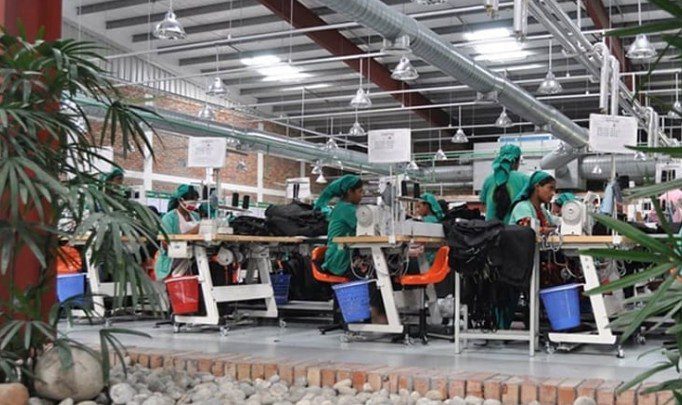Many Indian ready-made garment (RMG) manufacturers are planning to move their production to Bangladesh to avoid higher tariffs imposed on Indian exports to the US.
The United States has already imposed a 25 per cent tariff on Indian goods. President Donald Trump has warned of an additional 25 per cent secondary duty for purchasing Russian oil – which will come into effect on August 27 this year.
Under these circumstances, Indian businesses are facing difficulties in exporting to the American market, with US buyers either placing Indian orders on hold or even discussing cancelling them altogether.
As a result, Indian companies are in deep trouble and are now exploring strategic ways out of the crisis, reaching out to Bangladesh to overcome these challenges.
Regarding the issue, Bangladesh Garment Manufacturers and Exporters Association (BGMEA) Senior Vice-President Inamul Haq Khan told TIMES of Bangladesh, “I have heard that some Indian companies are exploring Bangladeshi factories to produce goods for the US market. But it will take time to implement.”
“Apart from this, Pearl Global, a multinational apparel manufacturing company, is planning to shift parts of its production from India to Bangladesh and Vietnam, and they are already in contact with us.”
To calm US customers’ nerves, Pearl Global has offered to shift production to its 17 factories in Bangladesh, Indonesia, Vietnam, and Guatemala to bypass the steep US levies on Indian imports.
“All the customers are already calling me. They want us to shift from India to other countries,” said Pallab Banerjee, managing director of Pearl Global, in a recent interview with Reuters.
Pearl gets roughly half of its business from the United States. Some clients offered to continue sourcing products from India if the tariff burden could be shared, but Banerjee said this is not viable, without naming the customers.
BGMEA’s former president Anwar-ul Alam Chowdhury, however, said, “It is not the right time to say whether Indian production will shift to Bangladesh. The new tariffs will be executed after August 27 this year.
“On the other hand, the tariff rate on Indian goods may also come down. So, we must consider our own capacity to handle any expansion or setting up of new factories.”
As tariffs on Bangladesh remain comparatively lower, purchase orders from the US are rising day by day. To cope with the situation, workers in the factories are struggling to keep up.
BGMEA Director Shah Rayeed Chowdhury said, “Apparel orders have increased, and export volumes will rise this year compared to last year. However, there are concerns about how sustainable this growth will be.
“As a trade agreement between the US and India has not yet been finalised, if tariffs on India are later reduced, American buyers may return to Indian suppliers,” said Rayeed, who is also the director of Evince Group.
“The execution of extra orders will mainly begin from mid-October, and by that time, the production capacity of Bangladeshi factories will remain high. So, we are confident about meeting the challenge,” Rayeed added.
He further said orders may slow down after December, as national elections are approaching.
Many American companies are now placing garment orders in Bangladesh’s factories. In most cases, the orders cancelled in India are being redirected to Bangladesh. Even large Indian businesses are contacting Bangladeshi companies.
“Our factory has seen a surge in orders, mostly from US buyers,” said SM Khaled, managing director of Snowtex Group, a leading export-oriented garment manufacturer with annual exports valued at around $300 million.
“Last year, we exported 300,000 down jackets to a US buyer. This time, that buyer wants to increase the order to 500,000 pieces. Another buyer has begun negotiating for 150,000 pieces, up from 60,000 previously,” he said.
Khaled added that they are planning to increase factory capacity in response. “We will need to import new capital machinery. Currently, we operate 30 production lines but may expand to 45.”
Bangladesh exported garments worth $7.54 billion in the last fiscal year, and it is expected that the figure will reach a record $10 billion this year.
Sector insiders further stated that Chinese buyers and investors are exploring joint ventures in Bangladesh’s RMG supply chain (accessories, fabrics, trims), especially as US buyers shift sourcing away from China.
A knitwear factory owner, speaking anonymously, said, “I am already renting one factory to Chinese entrepreneurs. Last week, they showed interest in renting another.”
Industry insiders noted that Chinese investors are keen on both new investments and acquiring ready-to-use but currently closed factories.
Anwar Hossain, vice-chairman of the Export Promotion Bureau, told TIMES of Bangladesh, “This is a big opportunity for us as many Indian businesses are planning to shift their production to Bangladesh.
“The production efficiency of our country’s factories has increased significantly in recent years to meet the changing reality.”


